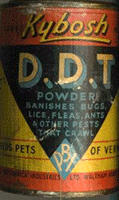Africa needs DDT, not "blah, blah, blah"
As malaria death rates rise in Africa and other parts of the third world, some Africans are demanding change
 We have heard a lot about "African voices" and "what Africans want" recently. One thing they want is to be able to use DDT, or at least a reliable alternative. During a visit to Berlin in May, Alcinda Abreu, Mozambique foreign minister asked the industrialised world to "provide alternative methods to fight malaria or else drop opposition to using DDT against mosquitoes." Following reports that DDT was harmful to the environment, it was banned in the USA by the Environmental Protection Agency (EPA) in 1972. This led to an effective worldwide ban, as countries dependent on US-funded aid agencies stopped their use of the pesticide.
We have heard a lot about "African voices" and "what Africans want" recently. One thing they want is to be able to use DDT, or at least a reliable alternative. During a visit to Berlin in May, Alcinda Abreu, Mozambique foreign minister asked the industrialised world to "provide alternative methods to fight malaria or else drop opposition to using DDT against mosquitoes." Following reports that DDT was harmful to the environment, it was banned in the USA by the Environmental Protection Agency (EPA) in 1972. This led to an effective worldwide ban, as countries dependent on US-funded aid agencies stopped their use of the pesticide.
Now, as malaria death rates rise in Africa and other parts of the third world, some Africans are demanding change. When she was asked about environmental campaigners who oppose the use of DDT, Alcinda Abreu said, "They have to give us alternatives... not blah, blah, blah." She proposed the development of an "effective and easy to administer vaccine," and said that Mozambique intended to start re-testing the use of DDT in the fight against malaria because no reliable alternative had been developed. Other countries, including Zimbabwe, have also said they will start using DDT again.
DDT started to be seen as an enemy of the environment following the publication of Rachel Carson's book Silent Spring in 1962. In her book, Carson puts DDT in the same category as other herbicides and insecticides with proven side effects, although there was no proof of side effects caused by using DDT.
Carson focused much of her attention on the apparent damage caused to birds by DDT. She wrote about robins at Michigan State University that were dying as a result of DDT. Michigan ornithologist George Wallace theorised that they were dying as a result of eating insects contaminated by DDT. Neither Wallace nor Carson spoke about the high levels of mercury at Michigan as a result of fungicide treatments on the campus and that the dead birds had symptoms of mercury poisoning. At the EPA investigations on DDT in the late 1960s, Joseph Hickey of the University of Wisconsin said that he had been unable to diagnose DDT poisoning at Michigan because the birds passed it through their digestive systems and eliminated it in their faeces.
Carson also wrote of Dr James De Witt's experiments which showed that, although DDT may cause no discernible damage to birds themselves, it may seriously affect their reproduction and reduce the number of eggs. In fact De Witt had a very different conclusion. He reported no significant difference in eggs hatching between birds fed DDT and birds not fed DDT. Carson also didn't mention De Witt's report that pheasants fed with DDT hatched about 50 percent more eggs than control pheasants.
In the late 1960s, Dr Joel Bitman and his colleagues at the US Department of Agriculture found that Japanese quail fed DDT produced eggs with thinner shells and less calcium. But further examination of Dr Bitman's study revealed that quails in the experiment had been fed a diet with a calcium content of only 0.56%, when a normal quail diet contains 2.7% calcium and calcium deficiency causes thin eggshells.
After much criticism, Dr Bitman repeated the tests with sufficient calcium levels and the birds produced normal eggs. After years of feeding experiments, scientists at the department of Poultry Science at Cornell University "found no tremors, no mortality, no thin eggshells and no interference with reproduction caused by levels of DDT as high as those reported in wild birds where "catastrophic" decreases in shell quality and reproduction were claimed."
Various things cause thin eggshells, including season of the year, nutrition, temperature rises, type of soil and breeding conditions.
The campaign against DDT continued after Carson's death in 1964. In 1969 a study found a higher incidence of leukaemia and liver tumours in mice fed with DDT than in non-exposed mice. But scientists protested that the laboratory-animal studies ignored epidemiology saying that DDT had been used during the previous 25 years with no increase in liver cancer in any of the populations where it had been used. When the World Health Organisation (WHO) investigated the 1969 mice study, it discovered that both cases and controls had developed a high number of tumours. Further investigation revealed that the food fed to both mice groups were contaminated with aflatoxin, a carcinogen. When the tests were repeated using non-contaminated food, neither group developed tumours.
Most importantly, DDT is not dangerous to humans or the environment. Tests by Dr Phillip Butler, director of the US Fish and Wildlife Service's Sabine Island Research Laboratory, found that "92% of DDT and its metabolites disappear" from the environment after 38 days and humans have no problems passing DDT through their digestive tracts after small exposures.
In 1969 the director of the WHO said "DDT is so safe that no symptoms have been observed among the 130,000 spray men or the 535 million inhabitants of sprayed homes... therefore the WHO has no grounds to abandon this chemical which has saved millions of lives, the discontinuation of which would result in thousands of human deaths and millions of illnesses. It has served at least two billion people without costing a single human life be poisoning from DDT. The discontinuation of DDT would be a disaster to world health." This has proven to be correct in recent decades.
Even representatives from the WWF and Greenpeace were quoted in the New York Times on 8 January 2005 as saying that they would accept the use of DDT "if the alternative isn't working as they didn't in South Africa... if there's nothing else, and it's going to save lives, we're in favour of it. Nobody is dogmatic about it."
The real issue is about saving the lives of people in Africa and Asia where 20 million people have died from malaria since 1981, deaths that could have been prevented by DDT.
The article was contributed by Johan du TOIT
Subscribe to Pravda.Ru Telegram channel, Facebook, RSS!





